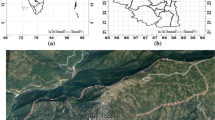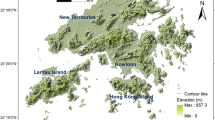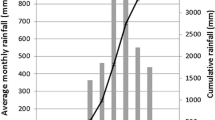Abstract
Many large landslides in the crystalline schist region of Shikoku Island, Japan, are susceptible to intense rainfall. Through the use of on-site monitoring systems, the activity of landslides and their meteorological triggers can be assessed. Continuous high-intensity rainfall was found to play a key role in provoking landslide movement. This paper investigates the influence of intense rainfall on the activity of crystalline schist landslides by examining rainfall and displacement of four typical landslides. By defining and calculating the effective rainfall and the relative landslide displacement, the relationship between intense rainfall and rainfall-induced landslide movement was analysed. Results indicate that the intense rainfall-induced landslide movement can be correlated with the effective rainfall. From these results, two rainfall thresholds were identified for the landslide risk management of Shikoku Island.










Similar content being viewed by others
References
Ando T, Ohkubo T (1970) Remarks on landslides in crystalline schist areas, Tokushima prefecture, Shikoku (in Japanese). Bull Geol Surv Jpn 21(7):1–42
Bhandary NP, Yatabe R, Yagi N, Yokota K (2001) Some prominent creeping landslides in Shikoku region of Japan. In: Proceedings of the international symposium on geotechnical and environmental challenges in mountainous terrain, Kathmandu, Nepal, Vol 1, pp 246–252
Brand EW, Premchitt J, Phillipson HB (1984) Relationship between rainfall and landslides. In: Proceedings of the fourth international symposium on landslides, Toronto, Vol 1. Ontario BiTech, Vancouver, Canada, pp 377–384
Caine N (1980) The rainfall intensity duration control of shallow landslides and debris flows. Geografiska Ann 62A:23–27
Cannon SH, Ellen SD (1985) Rainfall conditions for abundant debris avalanches, San Francisco Bay region, California. Calif Geol 38(12):267–272
Dai FC, Lee CF (2001) Frequency–volume relation and prediction of rainfall-induced landslides. Eng Geol 59:253–266
Fujita T, Ando N, Tanaka K, Hakamada N (1973) Study of landslides in crystalline schist areas, Tokushima prefecture, Japan (in Japanese). J Jpn Soc Eng Geol 14(1–2):65–69
Furuya G, Sassa K, Hiura H, Fukuoka H (1999) Mechanism of creep movement caused by landslide activity and underground erosion in crystalline schist, Shikoku Island, southwestern Japan. Eng Geol 53:311–325
Hiura H (2000) Movement characteristics of Nishi-ikawa landslide by the automatic extensometer observation. In: Report of mutual study of Disaster Prevention Research Institute, Kyoto University (11G-11), pp 65–69
Hiura H, Sassa K, Fukuoka H (1991) On the mechanism of a crystalline schist landslide: landslide movement and the underground erosion. In: Proceedings of Soviet–China–Japan symposium and field workshop on natural disasters, Shanghai, Lanzhou, Urumgi, Alma-ata, Dushanbe and Kazselezashchita, USSR, pp 21–30
Hiura H, Sassa K, Fukuoka H (1992) Monitoring system of a crystalline schist landslide-three dimensional displacement meters and underground erosion. In: Proceedings of 6th international symposium on landslides, Christchurch, Vol 2. Balkema, Rotterdam, pp 1141–1146
Hiura H, Maeda H, Mori N (2001) The contribution of clay minerals on the reactivation of landslides in Sanbagawa metamorphic belt in Shikoku. In: Proceedings of the international symposium on geotechnical and environmental challenges in mountainous terrain, Kathmandu, Nepal, Vol 1, pp 80–89
Ibsen ML, Casagli N (2004) Rainfall patterns and related landslide incidence in the Porretta-Vergato region, Italy. Landslides 1(2):143–150
Japan Sabo Association (2001) Sabo in Japan—creating safe and rich green communities. Jpn Sabo Assoc Jpn
Kato J, Hada S (1980) Landslide of the Yoshimo-gawa water system and its geological aspects (in Japanese). Res Rep Kochi Univ, Nat Sci 28:127–140
Kay JN, Chen T (1995) Rainfall–landslide relationship for Hong Kong. Geotech Eng, Proc Inst Civil Eng 113:117–118
Pun WK, Wong ACW, Pang PLR (1999) Review of landslip warning criteria. Special Project Report, SPR 4/99, Geotechnical Engineering Office, the Government of the Hong Kong Special Administrative Region
Sassa K (1984) Monitoring of a crystalline schist landslide: compressive creep affected by “underground erosion”. In: Proceedings of 4th international symposium on landslides, Toronto, Vol 2. University of Toronto Press, Downs View, pp 179–184
Sassa K, Takei A, Kobashi S (1980) The movement and the mechanism of a crystalline schist landslide “Zentoku” in Japan. In: Proceedings of INTERPRAEVENT 1980, Bad Ischl, Vol 1, Forschungsgesellschaft für vorbeugende Hochwasser bekämpfung, Klagenfurt, pp 85–106
Suemine A (1984) Monitoring of propagation of subsurface deformation in a crystalline schist landslide, INTERPRAEVENT, Villach, Vol 2, pp 61–72
Yano K (1990) Study of the method for setting standard rainfall of debris flow by the reform of antecedent rain. J Jpn Soc Erosion Control Eng 43(4):3–13
Acknowledgements
The authors would like to thank the Ministry of Construction Works, the Japan Forestry Agency and the Civil Engineering Department of Kochi Pref. for the provision of data. Appreciation is also given to Dr. Gen Furuya of Kyoto University, for his kind instruction on field observation. The authors’ special thanks go to Prof. Casagli, Dr. Petley and Dr. Ibsen for their useful comments and advices used to revise the manuscript.
Author information
Authors and Affiliations
Corresponding author
Rights and permissions
About this article
Cite this article
Hong, Y., Hiura, H., Shino, K. et al. The influence of intense rainfall on the activity of large-scale crystalline schist landslides in Shikoku Island, Japan. Landslides 2, 97–105 (2005). https://doi.org/10.1007/s10346-004-0043-z
Received:
Accepted:
Published:
Issue Date:
DOI: https://doi.org/10.1007/s10346-004-0043-z




